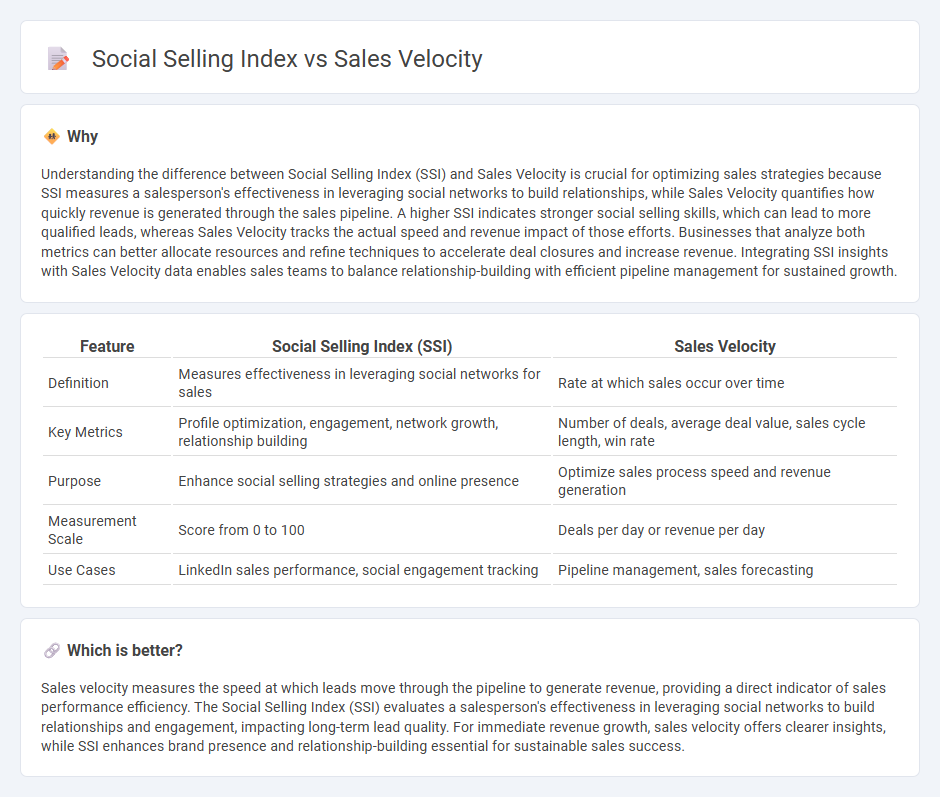
Sales velocity measures how quickly deals move through the pipeline, while the Social Selling Index (SSI) evaluates how effectively sales professionals leverage social networks to engage prospects. High SSI scores often correlate with increased sales velocity due to stronger relationships and targeted outreach. Discover how integrating SSI strategies can accelerate your sales cycle and boost revenue.
Why it is important
Understanding the difference between Social Selling Index (SSI) and Sales Velocity is crucial for optimizing sales strategies because SSI measures a salesperson's effectiveness in leveraging social networks to build relationships, while Sales Velocity quantifies how quickly revenue is generated through the sales pipeline. A higher SSI indicates stronger social selling skills, which can lead to more qualified leads, whereas Sales Velocity tracks the actual speed and revenue impact of those efforts. Businesses that analyze both metrics can better allocate resources and refine techniques to accelerate deal closures and increase revenue. Integrating SSI insights with Sales Velocity data enables sales teams to balance relationship-building with efficient pipeline management for sustained growth.
Comparison Table
| Feature | Social Selling Index (SSI) | Sales Velocity |
|---|---|---|
| Definition | Measures effectiveness in leveraging social networks for sales | Rate at which sales occur over time |
| Key Metrics | Profile optimization, engagement, network growth, relationship building | Number of deals, average deal value, sales cycle length, win rate |
| Purpose | Enhance social selling strategies and online presence | Optimize sales process speed and revenue generation |
| Measurement Scale | Score from 0 to 100 | Deals per day or revenue per day |
| Use Cases | LinkedIn sales performance, social engagement tracking | Pipeline management, sales forecasting |
Which is better?
Sales velocity measures the speed at which leads move through the pipeline to generate revenue, providing a direct indicator of sales performance efficiency. The Social Selling Index (SSI) evaluates a salesperson's effectiveness in leveraging social networks to build relationships and engagement, impacting long-term lead quality. For immediate revenue growth, sales velocity offers clearer insights, while SSI enhances brand presence and relationship-building essential for sustainable sales success.
Connection
The Social Selling Index (SSI) directly impacts Sales Velocity by enhancing relationship-building and engagement with potential clients, leading to faster deal closures. A higher SSI score reflects improved leverage of social networks for prospecting, which accelerates the sales cycle and increases the number of opportunities converted into revenue. By optimizing LinkedIn activities and social interactions, sales professionals can boost their SSI, thereby driving increased sales velocity and overall performance.
Key Terms
Pipeline
Sales velocity measures the speed at which opportunities convert into revenue, emphasizing pipeline acceleration and deal closure rates. The Social Selling Index (SSI) evaluates a salesperson's effectiveness on social platforms to build relationships and influence buyers, directly impacting lead generation and pipeline quality. Explore how optimizing both metrics can drive stronger pipeline growth and sales performance.
Engagement
Sales velocity measures the speed of revenue generation by tracking the number of deals closed, average deal size, and sales cycle length, while the Social Selling Index (SSI) emphasizes engagement metrics such as connection strength, content sharing, and interaction quality on social media platforms. High engagement in SSI enhances relationship-building and trust, directly influencing sales velocity by shortening sales cycles and increasing deal sizes through relevant interactions. Explore detailed strategies on leveraging social engagement to accelerate your sales velocity and boost business growth.
Conversion
Sales velocity measures the speed at which deals move through the sales pipeline, emphasizing deal size, win rate, and sales cycle length for maximizing revenue. Social Selling Index (SSI) evaluates a salesperson's effectiveness in leveraging social networks, particularly LinkedIn, to build relationships and engage prospects, impacting lead quality and conversion likelihood. Explore detailed strategies to enhance both metrics and boost your conversion rates effectively.
Source and External Links
Sales Velocity: What It Is & How to Measure It - Sales velocity is calculated by multiplying the number of qualified opportunities, average deal value, and win rate, then dividing by the length of the sales cycle, which helps organizations understand how quickly they are generating revenue and identify areas for improvement.
What Is Sales Velocity and How Do I Calculate It? - Sales velocity measures the speed at which a sales team generates revenue and is calculated by (Number of Opportunities x Average Deal Value x Conversion Rate) / Sales Cycle Length, offering valuable insights into sales efficiency and areas for optimization.
Sales Velocity: How to Use This Metric To Boost Sales (2025) - Sales velocity tracks how fast qualified leads move through the sales funnel, using the formula: Number of Opportunities x Win Rate x Deal Size / Sales Cycle Length, which allows businesses to forecast revenue and improve sales processes by focusing on these factors.
 dowidth.com
dowidth.com